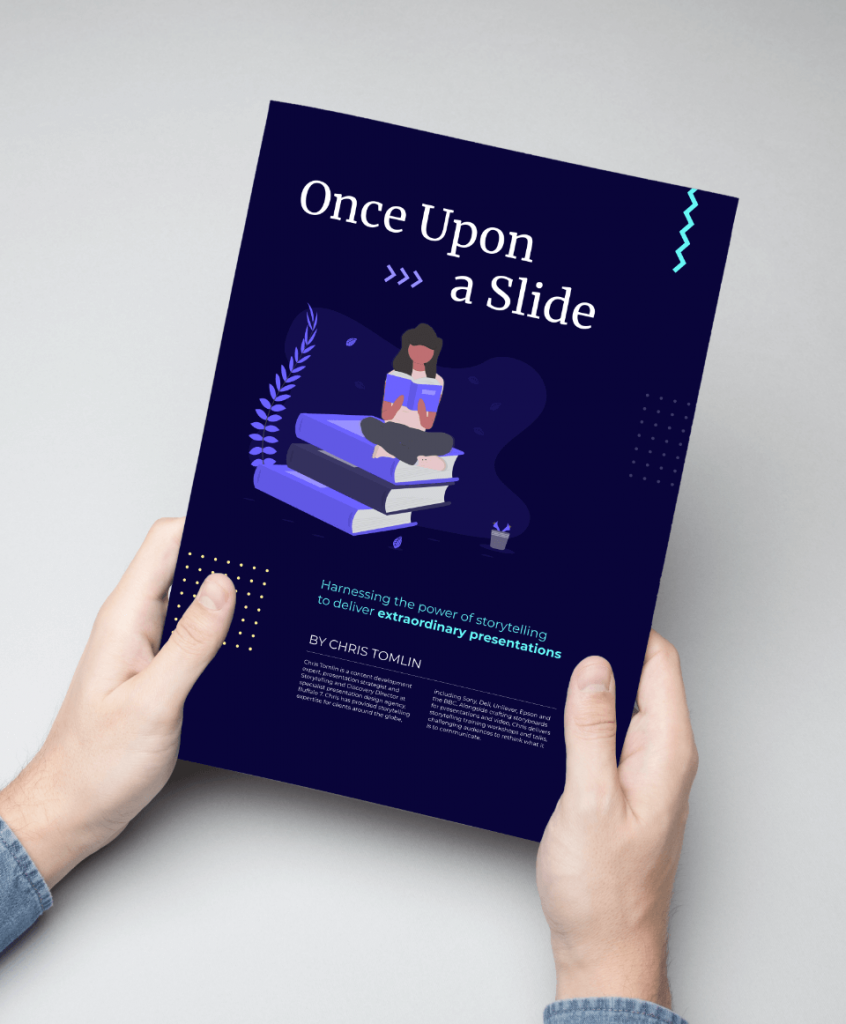In this blog post, we’ll look at what makes for great corporate storytelling, the main elements you need to hone your narrative and the best ways to deliver your story.
Corporate storytelling, or storytelling for business, has been a hot topic in recent years. While some people still scoff at it and maintain stories are for kids, the more enlightened and forward-thinking among our industry understand the power of a well-structured, emotional and persuasive story. Even if you’ve already crafted your perfect story – what then? How do you get it into people’s hearts and minds? How do you get them to act on it?
What do we mean by corporate storytelling?

Corporate storytelling can mean a lot of things to different people.
Some want to tell a literal story about how their company developed from a start-up in a bedroom to a multi-national corporation.
Others want a way to clearly and concisely explain complex concepts, cutting out jargon and communicating on an emotional level.
Others want a way to differentiate themselves; to cut through the noise and become heard in a maelstrom of comms chatter.
Some people need a way to humanise data, to move away from tedious charts and spreadsheets so they can engage an audience, rather than alienate them.
There are those that want to share customer experiences to illustrate how their services can make the world a better place.
And those who want to create or develop a whole new brand identity, employing some beautifully-crafted narrative to complement the visuals.
But in the end, it all boils down to the same simple concept: simplifying the complex to persuade audiences. Whether you’re persuading them to buy, to get on board, or just to listen to a different point of view, storytelling for business is a very real, very valuable skill that you can’t afford to pass on.

What does it mean to tell a corporate story?
We all know that, as humans, we love a good story. Here’s a single stat that tells you all you need to know: after a presentation, 63% of attendees remember stories. Only 5% remember statistics (Chip & Dan Heath).
If you want your messaging to be memorable, tell a story. Got it.
But it’s not as simple as that, is it? Of course not.
Stories can be complex. They can go off on tangents. They just might not seem the right way to display data. Perhaps the whole notion of a story is too vague and subjective. We need a bit of clarity here.
When we’re talking about ‘telling stories’, what we really mean is ‘to present compelling narratives: clearly, unambiguously, and persuasively’.
How can I tell a persuasive story?
Some of the best storytellers in the business are lawyers: they need to persuade juries to believe their client’s version of events over anyone else’s. Even if you’ve never seen an actual lawyer in court, you’ll have seen a courtroom drama unfold in TV, and one thing is always clear: the lawyer capable of telling a persuasive story that engages the jury will always beat the lawyer who can’t.
But lawyers aren’t just born with this skill. They, like all other storytellers, follow a blueprint. This blueprint wasn’t devised by lawyers of old, or novelists, or even TED himself (not a real person). It was Aristotle that put this blueprint in place. And Aristotle called it the Rhetorical Triangle.
The three points of the Rhetorical Triangle are ethos, pathos and logos. Or, in modern parlance, credibility, emotion and logic. Let’s look at all three in turn – using our courtroom for context – and how to fit them together to create the perfect story to persuade your audience to buy what you’re selling, think what you’re thinking or do what you want them to do.
Emotion in corporate storytelling
Audiences’ emotional responses kick in before anything else, so you’ll see lawyers start with a gentle pull on the heart strings: telling a tale of a poor, down-on–his-luck family man who was just trying to put bread on the table for his starving family when defending a thief.
It’s a good idea to start your business story with a strong emotional impact too. Create a character, explain the challenges they face and the pain points in their life. But a word of warning: use emotion sparingly – emotional manipulation is a step too far and if you step over the line your audience will stop trusting you and you could lose them.
Logic in corporate storytelling
After a touch of that instinctual emotion, it’s time to engage the other side of the brain and bring in some logic. No audience will be sold on emotion alone. It’s the hard facts that they need to hear. This is corporate storytelling after all, so we need to get some data in there.
For lawyers, this is where they bring in the unmistakable evidence. “At exactly 23.30, the accused was seen entering Sainsburys, his face clearly visible on multiple CCTV camera, and took six bottles of Captain Morgan’s rum, making no attempt to pay for them. He knocked the security guard to the floor, who sustained a sprained wrist, before running down Market Street and into his own car, registered to the accused’s home address.”
In your presentation, this is where you’d share your science, technologies, expert perspective and so on. Just the facts that show your working in black and white (or in vivid technicolour, but we’ll get to design later…) By itself, this could be dry and boring, but by adding the other two elements, the magic formula is starting to work.
Credibility in corporate storytelling
The final part of the Rhetorical Triangle is credibility. You need to be seen as a credible source of information. Lawyers bring in expert testimony from doctors, scientists and other specialist authorities to prove their point. Or character witnesses to show how their client is really a decent human who does lots for his family, community and charities.
You too should look to introduce independent testimonials and case studies, to back up your claims.
Creating the perfect triangle
To be persuasive, your argument needs to have elements of all three of these elements. In what ratios though? That depends on many variables, and is often down to trial and error. If it’s not quite working, ramp up one area and tone down another to get the perfect mix.
If you’re looking for tailored advice about the best way to tell your story, make sure to get in touch and take the first step towards corporate storytelling your audience will connect with.
What’s the best channel to tell my story?

Now that we have a tried-and-tested formula on which to base your story. What happens next? How do you actually tell your story? What channels should you use for maximum impact?
You could see this punchline coming a mile off, but we genuinely believe presentations to be the most effective vehicle for your corporate story.
But not just any presentation. It needs to be good. To be persuasive. This goes back to one of the elements of the Rhetorical Triangle: having a slick, professional presentation shows audiences that you’re credible, before you even open your mouth. It shows that you can be trusted. That people should listen to you.
But what about the other two elements? Yep, they’re essential in creating an engaging presentation to act as a corporate storytelling channel too.
Let’s think about logic. We mentioned earlier that these solid facts and figures are an essential part of your story, but throwing an ugly chart up can disengage your audience instantly. Data needs to be delivered in a clear, but exciting way. Would you look at that: we’re adding emotion into the mix too.
Visual corporate storytelling
Every piece of data you collect is telling a story. It’s likely that story is immediately obvious to you, but may not be so clear to your audience. Strong presentation design can draw the story out of your data and lay it lovingly on a slide in an engaging and personality-packed way.
With just one glance, your audience will not only understand your message and acknowledge your credibility, but their eyeballs will be super happy too.

Illustrations are another visual way to explain an idea or tell a corporate story, and they come in many styles, so you’re sure to find one that matches your brand style and suits your audience. Illustrations are versatile, aesthetically pleasing, and they have the freedom to exist without words, while still communicating powerful ideas in an instant.
As they don’t rely on reality, using illustrations in your presentation design gives you the opportunity to create something truly original and communicate complex and abstract ideas clearly.
Blending corporate storytelling and design
Once you’ve passionately delivered your corporate story, it would be a knock to your confidence if your audience instantly forgot it. But that’s something we see regularly in our line of work.
But we don’t expect you to believe us purely based on anecdotal evidence. A study from the University of Alabama found that three days after a presentation, people remember:
- 10% of information from an oral presentation
- 35% of info from a visual presentation
- 65% of info from a combined visual and oral presentation
This is known as the multimedia principle.
Research also found that text-based instructions with a graphic improved students’ performance on a test by 89%. And it makes sense, if you think about it. More than 80% of the information that our brains are processing is visual (University of Alabama). All this tells us that imagery is essential. But not just any images.
Think high-quality, high-resolution images from trusted sources. The best images are relevant, thought-provoking and emotive. They get people thinking. But you want people to be thinking positive things. This is the emotion part. Some images, like stock photos, will only make people question your judgement and taste. The world doesn’t need any more pictures of people high-fiving in suits.
This is taking us back to credibility.
Now it’s your turn
By combining the three elements of the Rhetorical Triangle, and adding some visual storytelling techniques, you have a ready-made template for great corporate storytelling, whatever complexity you are looking to simplify.
Want to see what this advice looks like in practice? Check out how we transformed Outright Games’ presentation into an immersive, playful and persuasive story.


